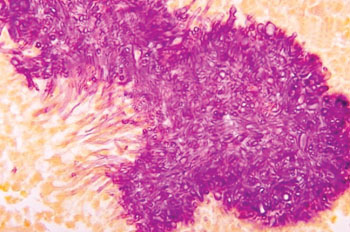Black Grain Eumycetoma Causative Agents Identified by Molecular Method
By LabMedica International staff writers
Posted on 18 Dec 2014
A rapid, simple, and highly efficient molecular based method for identification of the causative agents of black grain eumycetoma has been introduced, aiming to improve diagnostics in endemic areas. Posted on 18 Dec 2014
Accurate identification of mycetoma causative agent is a priority for treatment; however, current identification tools are far from being satisfactory for both reliable diagnosis and epidemiological investigations and the currently available molecular methods based on DNA sequencing though specific are extremely expensive.

Image: Histopathological appearance of Black Grain Eumycetoma caused by Madurella mycetomatis (Photo courtesy of Dr. Libero Ajello).
Scientists at the University of Amsterdam (The Netherlands) collaborating with an international team, analyzed 62 isolates belonging to eight species causing black grain mycetoma: 32 Madurella mycetomatis, 1 M. fahalii , 3 M. pseudomycetomatis, 2 M. tropicana, 10 Trematosphaeria grisea, 6 Falciformispora senegalensis, 2 F. tompkinsii, and 6 Medicopsis romeroi. All strains were identified down to species level by sequencing of the ribosomal DNA (rDNA) internal transcribed spacer (ITS) region.
Rolling circle amplification (RCA) is a powerful diagnostic method based on detection of specific nucleic-acid sequences and enzymatic amplification of circularized oligonucleotide probes under isothermal conditions. The probes are linear oligonucleotides that contain two target-complementary sequences at their ends joined by linkers. The ends of the probe hybridize to the complementary target in juxtaposition and then ligate which allows the circularization of the probe. The circular structured molecule then amplifies with DNA polymerase that has strand displacement and progressive DNA synthesis activity resulting in series of repeats of the original circular template. After RCA, accumulated double stranded DNA was detected with an ultra violet (UV) transilluminator (Vilber Lourmat; Marne-la-Vallée, France).
RCA was used to identify 62 strains belonging to eight species causing human eumycetoma. Since black grain eumycetoma species are known to be phylogenetically distant, it was easy to find unique sites for their identification. The ribosomal ITS region was sufficient for identification of all species and showed no intraspecific variability within a set of 100 M. mycetomatis strains in the collection. With the isothermal RCA assay, the 62 isolates were successfully identified with 100% specificity and no cross reactivity or false results.
The authors concluded that RCA is extremely useful for specific identification of agents of mycetoma. Performance and rapid turnaround time features make the RCA suitable for quick and reliable diagnosis, which is an enormous improvement compared to the current phenotypic identification of mostly non-sporulating cultures. Future application of RCA could be the detection of agents DNA directly from clinical samples without requirement of culturing. The study was published on December 4, 2014, in the journal Public Library of Science Neglected Tropical Diseases.
Related Links:
University of Amsterdam
Vilber Lourmat








 (3) (1).png)





